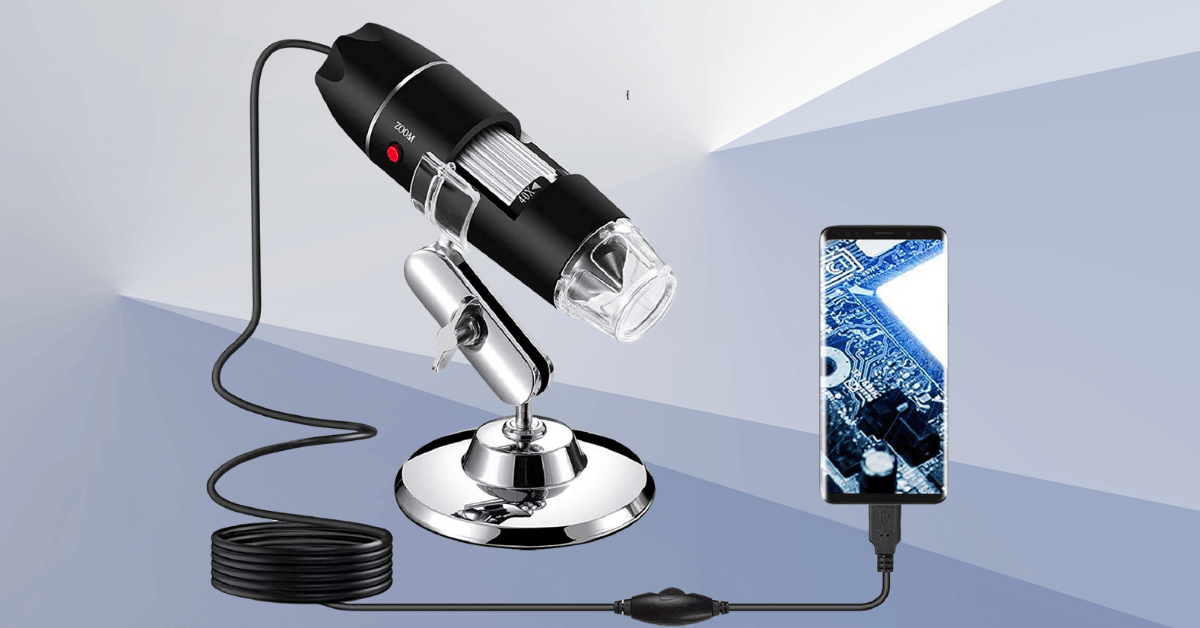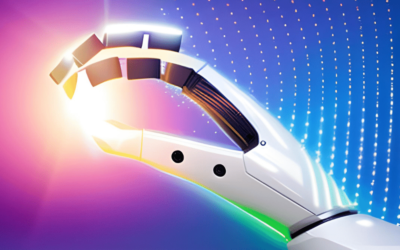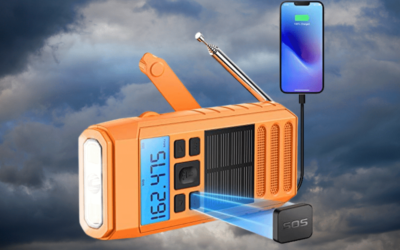If you’re looking to see the smallest of details, you need the best USB microscope at your disposal. Whether you’re a student, hobbyist, or in a professional field that requires zooming in on tiny specs, a USB microscope can be the perfect accessory for your work. Let’s dive into some of the best USB microscopes out there and explore why they may be right for you!
A USB microscope is an electronic device that can be linked to a computer via a USB connection for capturing or displaying digital images or videos. Over the last few years, the use of USB microscopes has increased significantly in educational, industrial, and research applications. While traditional microscopes utilize an optical lens system for magnifying objects, USB microscopes use a combination of optics and digital imaging technologies to capture and view such objects.
USB microscopes consist of three parts: a probe lens attached to the computer’s USB port with an attached connecting cable, an eyepiece with focusing capabilities on the end of the probe lens, and software driving control functions. In recent years most manufactures have focused on producing ‘plug & play’ models which allow users to quickly connect their microscope to their computer with no additional hardware or software installation required.
USB microscopes have become popular due to their small size compared to traditional optical microscope systems making them more suitable for field work applications where portability is paramount. Ideal applications include electronics inspection and assembly work as well as biological scientific studies in medicine, environment or genetics Research clubs can also benefit from having access to pocket-sized devices for examining microscopic life forms or identifying damage types associated with plants for indoor horticulture experiments. Furthermore, collections of rare coins or stamps can be conserved by using these digital systems instead of handling each piece individually under a traditional microscope lens.
Top 5 USB Microscopes in 2025
The availability of USB microscopes has increased significantly in recent years, making them a great tool for a variety of applications. Whether you are using them to inspect specimens or solder components on an electrical circuit board, there are several high-quality models on the market that make the job easy.
When choosing a microscope, it is important to consider your needs and budget. Do you need higher magnification? Does it need to fit into a tight space? Do you prefer USB over optical? Here is a look at some of the best USB microscopes currently available:
- Capture, Record & Measure: Connected this handheld microscope to devices, you can capture screenshot image and even record a video with installed software. Please note that the measurement software only works for WINDOWS user.
- Hobby Focused: Explore the microscopic world with ease; ideal for students, collectors, and testers. Use as an electronics microscope, soldering microscope, USB coin microscope, and more. Capture single images, time-lapse, and video.
- Strong Function: 1000X USB magnifier, comes with 8 LED light, the illumination of inspection area can be adjusted by the brightness wheel. Capture screenshot and record video of the micro world, this brings clear and stable image when using.
- 4.3” Crisp Display: With 720P HD digital imaging, the LCD screen displays real-time clear images and good quality videos in full lighted view with 8 LED fill lights; A large screen enhances ergonomics and eliminates eye and neck strain
- 【4K WiFi Microscope New Generation】 Jiusion 4K 3840x2160P portable hand held microscope is a useful and funny magnification for kids, children, students, engineers and others who need to magnify and explore the micro things like circuit board, coin, jewelry, skin and insect.
By researching which model best fits your needs and comparing features against price points, you can easily find the perfect USB microscope for your work space.
Types of USB Microscopes
USB microscopes come in various types and shapes, each of which offers different features and capabilities. It’s important to know the main differences between these types so you can make an educated decision regarding the best choice for your needs.
Binocular USB microscope – This type of microscope usually works with a set of eyepieces that contain magnifying lenses to view specimens. Depending on the model, some binocular microscopes may offer additional flexibility and components such as fine-focus adjustment rings, coaxial focuses, and illumination control knobs.
Monocular USB microscope – The monocular measurement microscope typically contains a single eyepiece connected to a focusing system that magnifies the specimen being viewed. It is designed to provide basic visual information at higher magnifications, allowing users to quickly measure dimensions without complicated calibrations or operations.
Trinocular USB microscope – A newer type of USB microscope is the trinocular model that comes with two eyepieces and a middle port shaped like an eye socket where a digital camera can be attached for photographing specimens. This type is perfect for research labs that need accurate results from microscopy tests using still images or videos.
Tabletop digital USB microscope with stand – Designed for working at greater magnifications, this type of USB microscope allows users to view specimens through an adjustable viewfinder without having them physically touch the unit. This provides the benefit of eliminating disturbing or damaging samples while still offering better viewing potential than handheld models do.
Benefits of Using USB Microscopes
USB microscopes are becoming increasingly popular due to their versatility and ease of use. While a traditional microscope can require a significant investment, USB microscopes are accessible and typically quite affordable. USB devices are typically digital in nature, which allows for quicker capture times and the ability to easily store images for future reference as opposed to more traditional analog optics. Also, many models include built-in features such as automatic calibration for getting started quickly and accurately.
USB microscopes also offer portability since they do not require an external power source or computer interface; all necessary functions can be performed within the scope itself. This makes them suitable for various situations, from research use in laboratories to medical settings such as hospitals or medical clinics. Additionally, USB microscopes support various media types including video capture and live streaming so that images can be shared with multiple viewers at once.
How to Choose the Best USB Microscope
If you’re looking for a powerful and versatile microscope, you may want to consider a USB microscope. USB microscopes connect directly to your computer or laptop via the USB port and are an ideal choice for viewing small objects such as crystals, insects and coins.
When selecting the best USB microscope for your needs, it’s important to take into consideration a number of different features including magnification level, resolution and light source type. Most microscopes have built-in LED lighting, but some models offer the option of additional illumination lights. Additionally, many microscopes can magnify objects up to 1000x with excellent clarity if used correctly.
When using a USB microscope, it is important to make sure that the software is compatible with your computer or laptop operating system and that you use appropriate adapters when necessary. There are some models that include internal digital storage capability so that you can store images without having to constantly resort back to your computer or laptop hard drive memory storage.
Furthermore, be sure that your software includes tools such as annotations and other specialized measurements tools in order to gain maximum use of your images taken through the microscope lens. In addition, consider purchasing an object holder pad which is designed especially for use with a USB microscope – this will help secure the object being viewed should there be any jerky sound when adjusting the focus knobs or a slipping table surface resulting in blurry images taken through the lens. Depending on what type of applications you plan on using it for – hobbyist/educational use or industrial/professional use – usability features should also be taken into account prior to purchase such as live video streaming capabilities or extended graphic capabilities when applicable .
How to Use a USB Microscope
USB microscopes are hand-held digital imaging devices that allow you to take magnification images from 10x up to 200x and beyond. For anyone wanting to explore the hidden world around us, USB microscopes can be an invaluable tool. Whether you’re a professional photographer, hobbyist, scientist, or student, a USB microscope can give you access to the “invisible” world.
One advantage of USB microscopes is that they have a much larger field of view than traditional magnifying lenses. This is because they use digital instead of optical lenses. Additionally, USB microscopes provide a wide range of adjustable settings including brightness and color saturation control as well as many special effects such as panorama and split window views. All these features make them excellent for research and education.
Using a USB microscope is easy – simply plug it into your laptop or desktop computer’s USB port and install any required software provided with the microscope. Then launch your compatible application (e.g., Microsoft Windows Paint or Mac OSX Photo Booth) and adjust various settings for optimized viewing and capture images using the supplied button on top of the microscope body. It’s that simple!
Here are some best practices when using your USB microscope:
1) Use appropriate lighting when possible;
2) Start at low magnification levels;
3) Use gradual rather than rapid movements for adjusting focus- sometimes even small increments are critical;
4) Keep in mind lenses need periodic cleaning with either canned air or ideally lens paper specifically designed for optical cleaning purposes;
5) Resist zooming in too far without giving objects time to stabilize in focus – this will reduce blurring over time;
6) Record observations and take notes while working so interesting observations can be referred back to later;
7) Consider potential safety risks when dealing with potentially hazardous materials;
8) When working with delicate materials such as insects handle them gently and safely store them after observation is complete- particularly if specimens are being shared between individuals or classes;
9) As much as possible adjust lighting so it is kind enough not to damage live specimens while still providing necessary illumination needed for observation accuracy.
Common Troubleshooting Tips for USB Microscopes
If you’re having trouble connecting your USB microscope or viewing images successfully, you may find that there are some simple troubleshooting steps you can take. Before reaching out to customer service for help, consider trying the following Tips:
-Ensure that all the necessary software is installed correctly. Check for the latest update to ensure the best compatibility with your device.
-Check device connections and cable connections for any damage. Make sure any cables being used are properly connected at both ends and in good condition.
-Make sure that your computer is able to detect and recognize your USB microscope by checking in Device Manager (in Windows) or System Profiler (on Mac). The “Universal Serial Bus controllers” option should appear in this list.
-Check all settings on the camera itself and match them to your computer specifications (e.g., frame rate and resolution).
-Try uninstalling then reinstalling all software associated with the device, making sure to check for different versions of each if available.
If all else fails, contact customer service directly for further advice about how to use your particular USB microscope model effectively and troubleshoot any issues that arise quickly and effectively.
Conclusion
In conclusion, there are a wide range of USB microscopes available for diverse needs. You should consider the size, resolution and other features that are relevant to your purpose when choosing the right one. Additionally, different budget options should be taken into account. If you’re looking for an easy-to-use USB microscope with good image quality, a basic model with a resolution of 1280×720 is an ideal option. On the other hand, if you need higher magnification and better image quality that can only be provided by higher priced models. Quality typically never comes cheap but provides value in the long run.








